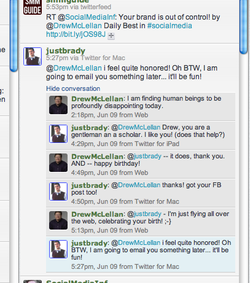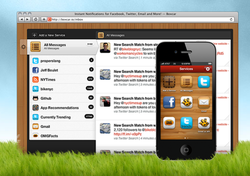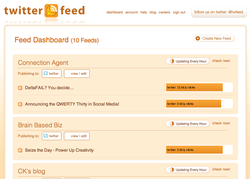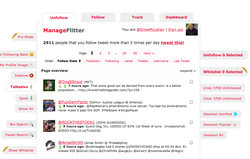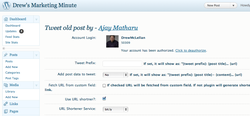I've talked about this before.
Many others have too.
My idea is if you have to brag about it, you probably aren't one.
If others give you props, that is more legit.
This is from CopyBlogger:

Gary Vaynerchuk, in his usual low-key, mellow way, said last month that 99.5% of social media experts are clowns.
This immediately prompted a schoolyard-style kicking of the whole idea of a social media expert, with one prominent writer saying that anyone who does it for a living should “go die in a fire.” And that was one of the nicer responses.
The name-calling and vitriol are a little hard to watch. Here’s the thing, though.
Vaynerchuk’s making a point that needs to be made. But that’s not what interests me.
What interests me is what it takes to make that last 0.5%. What do the social media experts look like who aren’t clowns?
First, let’s talk about that hated title.
Is “social media expert” a stupid thing to call yourself?
On one level, of course it is. “Social media expert” is like being an “internet expert.” It’s too broad, therefore it’s meaningless.
There’s just one problem with that. Businesses that need help with blogging strategies, content marketing, social networking presence, and real-time PR usually don’t know enough to look for those terms.
They look for “social media experts.”
You can make social media pundits happy and change your tag line to something more precise. Or you can find customers by calling yourself a social media expert, then educate your clients about what that actually means.
I’m personally in favor of making the people happy who pay me money. Just a thought.
Sturgeon’s Law of Predominant Crap
Most graphic designers are pretty bad. So are most copywriters. And most SEOs. Add in most novels, TV shows, restaurants, general contractors, PR professionals, financial advisors, real estate agents … you get the idea.
Sturgeon’s Law, coined by the science fiction writer Theodore Sturgeon, is that 90% of everything is crap.
Sure, it’s easy to find lots of social media experts who know nothing about either business or social media. Why should social media consulting be immune?
There’s more demand for good social media advice than there are practitioners who can give it. Any time demand outpaces supply, Sturgeon’s Law comes into play.
Do businesses really need help with social media?
Some believe that businesses don’t need help with social media at all — that if their products and customer service are good enough, the social media side just takes care of itself.
This is precisely as naive as thinking that if your social media relationships are good enough, the sales side will take care of itself.
(Here’s Sonia’s Law: Nothing Takes Care of Itself.)
There are thousands of businesses that do a pretty good job at what they do, and a spectacularly terrible job of using new internet-based communication tools.
90% of websites are wretched. 90% of Facebook pages are wretched. 90% of content marketing programs are wretched. 90% of social media-based customer support is wretched.
Saying that no one needs a social media expert is like saying no one needs a direct mail expert, or a radio advertising expert. It shows a lack of experience with just how badly otherwise good, smart companies can screw up when trying to use new communication tools.
Gary Vaynerchuck didn’t, in fact, say that 99.5 percent of social media experts are clowns. He said that “99.5 percent of the people that walk around and say they are a social media expert or guru are clowns” … because they don’t think like businesspeople.
Businesses need help from actual experts — people who really get the rules of engagement in social media, and who understand how to translate that to business success.
If you’re allergic to marketing and making money, don’t consult to businesses
One of the main reasons for all the Haterade is that too many high-profile social media pundits (who were then followed by vast herds of well-intentioned lemmings) loathe business. They imagine that sales are something that magically show up when you make lots of friends.
Any good salesperson will tell you you need to be able to make friends. Cultivating relationships has always been an essential part of sales, and it always will be.
But that’s not where it stops. You still need to demonstrate value for money, your product still needs to do great things for your customers, and you still have to ask for the sale.
Social media relationships don’t replace solid marketing strategy — they amplify it. Anyone who tells you otherwise is pontificating without benefit of experience or evidence.
Sometimes the best marketing doesn’t look like marketing. That doesn’t mean there’s no solid strategy in place — it usually indicates a strategy that’s absolutely brilliant.
How to get into in the 0.5%
Businesses need smart people who can help them figure social media out. That means they probably need someone who looks a lot like you.
If you’re smart about social media, then no matter what you do, your services got a whole lot more valuable in the last year.
So if helping businesses use social media is part of what you do, how do you make sure you’re in the effective, business-savvy, non-clownlike 0.5%?
- Understand content marketing. Social media friendliness is great, but content scales, and it doesn’t depend on any one particular platform.
- Understand direct response copywriting … in other words, writing that triggers a specific, well-defined action. Know how to write a great headline, how to make a call to action, what a landing page is, how to translate features into benefits. Learn what it takes to turn fans into customers.
- Be specific about your tool kit. Yes, you may initially approach your clients with the title of social media expert, but you’ll quickly educate them about your own specific areas of expertise.
- Partner with complementary experts. If you’re a Facebook and Twitter ninja, connect with a brilliant landing page and SEO copywriter, and maybe a smart PR pro who knows what a crisis plan looks like. You don’t have to know how to do it all, but you should be able to make it easy for your client to get everything they need.
- And to that point, Know what your clients need. Fortune 500s, mom-and-pops, VC-fueled startups, and small service businesses all have different needs, and they speak different languages. Read the business blogs or magazines your clients read. Become an expert in how your clients do business. Learn what they desperately want, and give it to them.
The fastest way to get (and stay) up to speed
If you’re some variety of “social media expert,” don’t let the backlash get you down. Sulking is not a business strategy. Educating yourself is.
If any of the points above is a weak spot for you, get up to speed fast by picking up our 20-part tutorial, Internet Marketing for Smart People. It will show you how to balance what’s new and shiny with the underlying business principles that make social media marketing work.
It’s free, it’s packed with techniques and strategies you can use again and again, and it’s the most efficient way to make yourself one of the kickass 0.5%.
Sign up for the complete free course here.
About the Author: Sonia Simone is co-founder and CMO of Copyblogger Media. Follow her on twitter and let her know what makes you one of kickass 0.5%.














